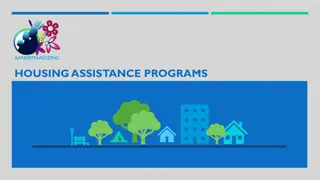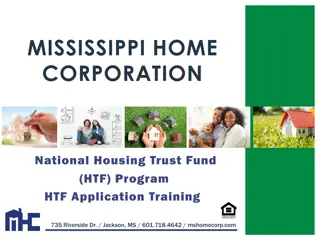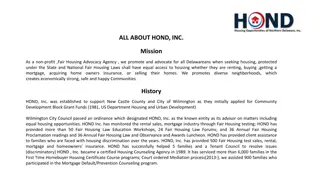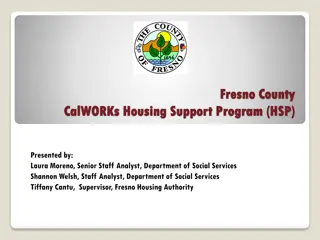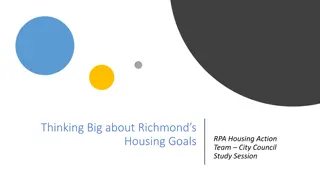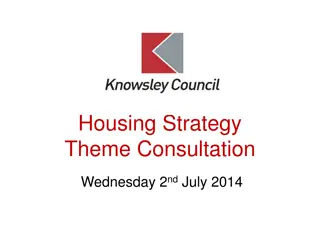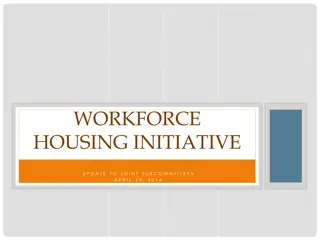Module 1 Housing Solutions: Adapting for Change Program Summary
In Module 1 of the Housing Solutions program, staff will learn about key principles and aims of the Adapting for Change program, effective identification of housing solutions, importance of early action, and supporting individuals in understanding available options. The key themes include partnership, governance, streamlined services, widened scope, and a person-centered focus. The program features demonstration sites in Aberdeen, Borders, Falkirk, Fife, and Lochaber, each implementing tests of change to improve housing services. Specific improvements range from integrating technology solutions to enhancing hospital discharge processes. These initiatives aim to provide better housing outcomes and services for individuals in need.
Download Presentation

Please find below an Image/Link to download the presentation.
The content on the website is provided AS IS for your information and personal use only. It may not be sold, licensed, or shared on other websites without obtaining consent from the author. Download presentation by click this link. If you encounter any issues during the download, it is possible that the publisher has removed the file from their server.
E N D
Presentation Transcript
Module 1 Housing Solutions
Module 1 | Housing Solutions Module Objectives By the end of the module staff will be able to Describe the key principles and aims of the Adapting for Change programme Outline the key considerations for the effective identification of Housing based solutions (exploring rehousing, technology, equipment, and adaptations) across all tenures Describe the importance of acting early and key elements of the right housing conversations Explain their role in supporting people to understand the options available 2
Module 1 | Housing Solutions Adapting for Change programme: Key Themes Partnership, governance and management strategy jointly developed, shared priorities, jointly accountable, better use of resources including money Better design less waste, better recycling... Streamlined services tenure neutral, reduced complexity, reduction in waiting times... Widened scope people with wider needs are supported e.g. dementia; wider range of options e.g. technology, self-help... Integrated easier access, seamless processes, effective signposting Person centred focus on evidencing personal outcomes Prevention timely provision, avoiding crisis! 3
Module 1 | Housing Solutions Adapting for Change 5 demonstration sites Aberdeen Borders Falkirk Fife Lochaber 4
Module 1 | Housing Solutions AfC 5 demonstration sites All 5 sites undertook tests of change in the following areas Plus specifically Aberdeen integrating TEC solutions , enhancing housing input to improve hospital discharge Improving partnership arrangements; strategy, processes and governance Borders tenure neutral approach with shared budgets amongst RSLs Service redesign to shorten timescales and enhance fast tracking Falkirk developing standardised tools, definitions and templates, plus a Joint Outcomes and Performance Framework Improving communication and choice and allied information and advice Fife new approach to triage at first point of contact and developing front line housing management and housing options role to provide speedier and more effective service Developing a person-centred approach with a focus on outcomes for the person https://ihub.scot/place- home-and-housing/ Lochaber tenure neutral approach with a one stop shop with direct access to a wide range of services 5
Module 1 | Housing Solutions Housing based solutions Housing Solutions = is an approach derived from the AfC programme and provides an overall framework for the provision of effective housing outcomes. It emphasises and supports: the importance of front-line staff acting early and having good housing conversations when someone's circumstances change, encouraging consideration of rehousing as first stage (Falkirk leaflet) Encourages an Asset based solutions approach, with the person having full ownership and control Recognises triggers , ..and supports Anticipatory care planning . Supports Prevention, and avoidance of crisis . and Appropriate risk taking .. Can be supported by local and national Housing Options services Technology telecare is an example of technology that can help people remain in their own home Equipment a wide range of cost effective/simple equipment solutions can support people in their own homes Adaptations any alteration or addition to the structure, access, layout or fixtures of accommodation and any equipment or fittings installed or provided for use in accommodation, for the purpose of allowing a person to occupy or to continue to occupy, the accommodation as their sole or main residence 6
Housing Solutions Housing Solutions, in action Mr F s story . Insert photo? SCW had a Housing Solutions conversation with Mr F, following a bathing assessment; Mr F agreed to consider rehousing & discuss with son; Mr F rehoused in smaller property and now able to go out and enjoy social activities. 7
Case studies Exercise 1 Acting early Read the case studies and discuss the following in your Groups: What should have been the triggers to intervene much earlier, and have a housing conversation ? who , should have done, what , and when ? 8
Case Studies peoples stories Mr D Home owner, age 76, lived in his family home for 41years - House over 2 floors with bathroom/bedroom upstairs - He has diabetes, a previous below knee amputation in 2014, & diagnosed with dementia in 2015 - Latest hospital admission resulted in a second below knee amputation - Previously had SW OT and housing involved following first amputation when identified that house not suitable for adaptation needs ground floor facilities and wheelchair accessible - Declined previous property offers, referred to housing and then again declined offer (after accepting) when he was in hospital the second time; - Refused to move, and against advice, privately fitted his own stairlift. SW reviewed their position and agreed to fit ramps, shower adaptation. - Mr D was admitted to hospital 1/9/15, he was ready for discharge 16/12/15 ..but was actually discharged in June 2016 (191 days delayed) - 9
Case studies peoples stories Mr G 73yrs old and lives alone in first floor private rented flat - He has diabetes and chronic renal failure (on dialysis at home) - Admitted to hospital for assessment 11/12/15 but with likely outcome of amputation. Ready for discharge 23/1/16 remained in hospital at July 2016 . - Rehousing first identified as an issue 22/1/16 (day before ready for discharge) - He needs 2 bedrooms to accommodate dialysis equipment and full wheelchair access. Current home assessed as not being suitable due to limited wheelchair access. - He refused new purpose built property as too far away . Offered second property in more suitable location but said this had come too soon - Refused to move to nursing home in the interim and remained in hospital .. - 10
Case studies peoples stories Mrs E Mrs E is 62 and lives alone in a ground floor HA flat. She has lived there for 22years. - She has diabetes, asthma, epilepsy and has had a stroke. Following hospital admission she is now a wheelchair user. - Admitted to hospital with cellulitis and was unable to mobilise. She is bariatric. - Had to be taken out of her property via the window due to her size. Property no longer suitable as too small for the equipment she requires; - Admitted to hospital 13/3/15; fit for discharge 15/6/15 - Mrs E is not prepared to accept that her property is unsuitable and wants to return there; - Had had a previous housing referral in May 2014 and then re-referred on the day she was ready for discharge 15/6/15 - Eventually she was moved into intermediate care but has not been rehoused . She reused an offer of sheltered housing as didn t understand what it was. - 11
Case studies peoples stories Mrs S Mrs is 85 and lives in her own home her mother was born in the house which is in a rural area; - Two storey property with main bathroom/bedroom upstairs. Toilet and sink downstairs, with large dining room, lounge and kitchen - Husband died 6 months ago. Her daughter lives next door. She want to remain in her home and is happy washing at the sink. - She is on medication for her heart condition, blood pressure, water retention and is now on anti-depressants. - She's had several falls both inside the home and when attending the local lunch club. She attended hospital for the external fall but did not tell staff about the other incidents. She has stopped attending the lunch club. - OT previously has installed rails. Physio has provided a walking stick and advised strength and balance exercises which Mrs S did not follow up. - Medication has been making her dizzy and GP has reviewed to try to improve these symptoms - 12
Case studies Exercise 2the right housing conversations Show the following clip to set the tone for this next exercise - https://vimeo.com/66753575 discuss the following in your Groups: What would the right housing conversation sound like - what would you say, how would you say it, who else could be involved? What should it not be ..? 13
Case studies Exercise 3 - Roles and Responsibilities discuss the following in your Groups: Recognising that Housing Solutions is about a different approach, encouraging earlier intervention, what do you think your Roles and responsibilities should be in trying to deliver a Housing Solutions approach? What will you do differently going forward ..? What information and support would help ? 14
Module 1 | Housing Solutions Roles and responsibilities . supporting personal outcomes Housing Solutions is everyone s business encourage communication and joint working between partners/agencies Sow the seeds , & be empowered to have a housing conversation signpost people and use leaflets /communication materials . Think simple solutions realistic and practical Focus always has to be on a personal outcomes approach 15
Module 1 | Housing Solutions Module Summary Any last Q s Evaluation 16
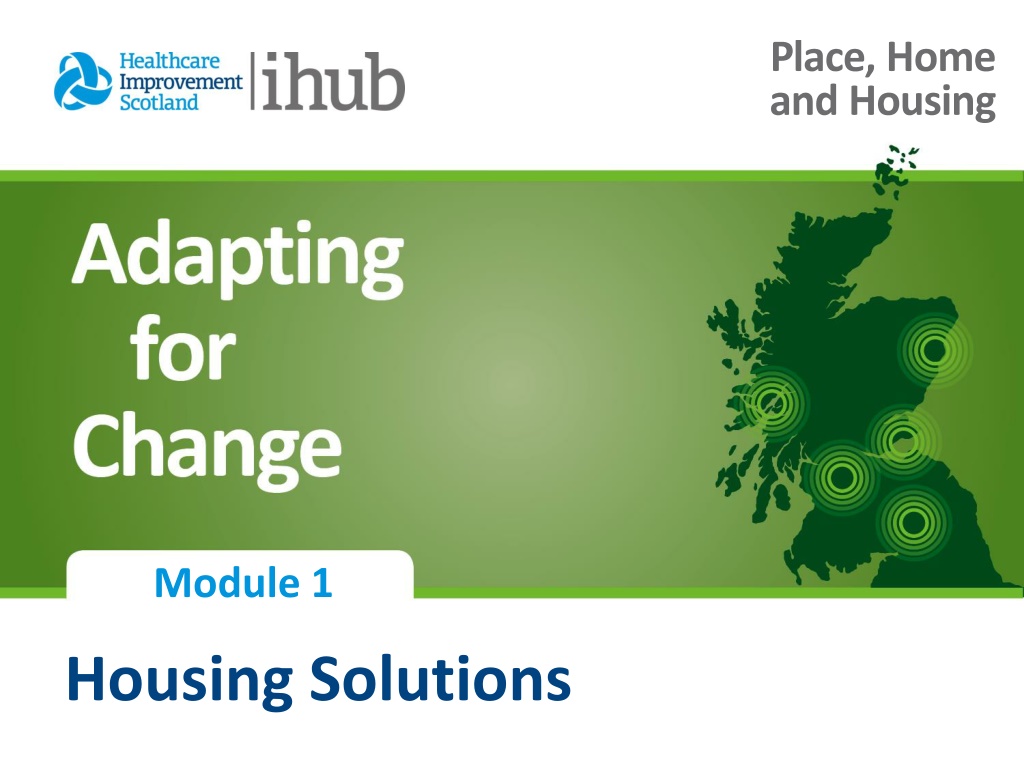
 undefined
undefined






